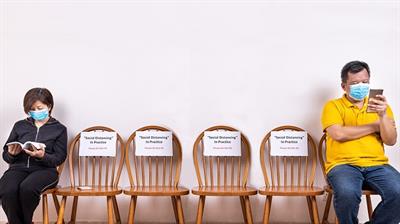
By now, you know about the need for social distancing to curb the spread of the new coronavirus. More recently, experts have recommended that you wear a mask or face covering when you aren’t able to keep 6 feet between yourself and others. But can
these simple acts keep people from getting the virus or passing it on?
The answer appears to be yes, and keeping distance from others may be the best way, according to a comprehensive study published June 1 in The Lancet.
But even when properly used, none of these interventions—distancing, wearing a mask or eye protection—can completely protect against COVID-19, the authors stressed. Until a vaccine is available, it’s best to use a combination of physical
distancing, masks and other recommended steps, including frequent hand washing.
For this study, researchers say they pooled all of the available evidence that looked at how physical distancing, face masks, and eye protection affect the spread of COVID-19, SARS and MERS, which are from the same family of viruses. The optimal use of
these protective measures in both the community and health care settings was examined. The review covered 172 observational studies across 16 countries and six continents.
The findings showed that standing just over 3 feet away
lowered the chance of infection or transmission from 12.8% to 2.6%. For every meter farther away the risk is lowered even more. Based on what we know, COVID-19 is spread by respiratory droplets, especially when someone sneezes, coughs and perhaps
talks. There is some debate about the role of aerosol spread. Experts say distancing has helped drive down COVID-19 cases by lessening the opportunity for virus-laden droplets to reach others and making it harder to transmit the virus. Some studies
have found that these droplets can travel much farther than 6 feet. None of the studies included in this review evaluated whether distances of more than 2 meters were more effective.
The researchers also found that wearing a mask—medical
grade or homemade—similarly lowers the likelihood of infection from 17.4% to 3.1%. Masks with multiple versus a single layer of fabric
are more effective. While masks appeared to do a better job of cutting the risk of transmission in hospital environments, they were found to be equally effective in both the health care and community settings when researchers adjusted for the
type of mask worn.
In addition, eye protection—for example, with face shields, goggles or glasses—was associated with lower risk of infection compared with no eye protection (6% vs 16%). Still as compared with physical distancing, the evidence for masks and eye protection while beneficial is less clear cut.
The research team said the findings have immediate and important implications
for curtailing the current COVID-19 pandemic and future waves of the virus. The review can help inform safer ways to gather as communities open up and activities resume.
The authors write that the results support policies of physical
distancing of at least 1 meter and, if feasible, 2 meters or more, and the use of well-fitting masks.
This research is limited to observational studies because no randomized controlled trials were identified. The study was funded,
in part, by the World Health Organization.
For more information, go to www.CardioSmart.org/Coronavirus.